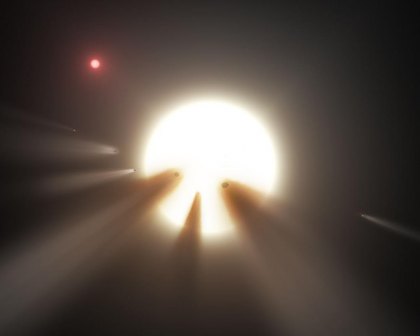Today's Post:
Mystery star dims, baffles scientists

A distant star is dimming at an unprecedented rate.
Illustration: NASA.
The star, designated KIC 8462852 and located some 1,500 light-years from Earth, first made headlines in the fall of 2015. Scientists, searching for exoplanets by observing “dips” in light that occur when a planet passes or transits in front of a star, described how one star experienced substantial dimming.
Some researchers speculated that this dimming could be caused by planetary remnants or comet fragments around the star. Others even suggested that the possibility of an alien "mega-structure" -- harnessing the star's energy -- could not be ruled out. (The SETI Institute later found no deliberately produced radio signals coming from the star.)
But now there is another twist. After examining four years of data, researchers found that the total brightness change of this star is "larger than that of any other star," identified by the Kepler space telescope. The Kepler is a NASA mission aimed at finding exoplanets.
The star faded nearly 0.34 percent per year during the first 1,000 days, according to a paper posted Aug. 5 on a Cornell University website. But it dimmed more rapidly in the next 200 days, dropping by more than 2 percent. It then leveled off and remained constant.
The star is often called "Tabby's Star," in honor of Tabetha Boyajian, a Yale astronomer who examined the unusual dimming in a research paper last year. Boyajian has raised more than $107,000 in a crowdsourcing campaign to fund attempts to determine what could be blocking the sun’s light. The money will be used to purchase time on a network of telescopes around the world that will monitor the star each night.
The recent paper by astronomers Benjamin T. Montet, a graduate student at the Cahill Center for Astronomy and Astrophysics, California Institute of Technology, and Joshua D. Simon of the Harvard-Smithsonian Center for Astrophysics, is available online.
Some researchers speculated that this dimming could be caused by planetary remnants or comet fragments around the star. Others even suggested that the possibility of an alien "mega-structure" -- harnessing the star's energy -- could not be ruled out. (The SETI Institute later found no deliberately produced radio signals coming from the star.)
But now there is another twist. After examining four years of data, researchers found that the total brightness change of this star is "larger than that of any other star," identified by the Kepler space telescope. The Kepler is a NASA mission aimed at finding exoplanets.
The star faded nearly 0.34 percent per year during the first 1,000 days, according to a paper posted Aug. 5 on a Cornell University website. But it dimmed more rapidly in the next 200 days, dropping by more than 2 percent. It then leveled off and remained constant.
The star is often called "Tabby's Star," in honor of Tabetha Boyajian, a Yale astronomer who examined the unusual dimming in a research paper last year. Boyajian has raised more than $107,000 in a crowdsourcing campaign to fund attempts to determine what could be blocking the sun’s light. The money will be used to purchase time on a network of telescopes around the world that will monitor the star each night.
The recent paper by astronomers Benjamin T. Montet, a graduate student at the Cahill Center for Astronomy and Astrophysics, California Institute of Technology, and Joshua D. Simon of the Harvard-Smithsonian Center for Astrophysics, is available online.
Related:
In Brief: U.S. astronaut sets record
If you would like to comment, give us a shout, or like us on Facebook and tell us what you think.

